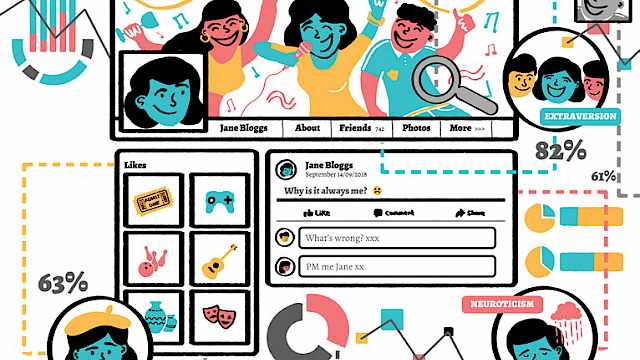Joanne Hinds
Projects
Articles
Academic Publications
What demographic attributes do our digital footprints reveal? A systematic review
To what extent does our online activity reveal who we are? Recent research has demonstrated that the digital traces left by individuals as they browse and interact with others online may reveal who they are and what their interests may be. In the present paper we report a systematic review that synthesises current evidence on predicting demographic attributes from online digital traces. Studies were included if they met the following criteria: (i) they reported findings where at least one demographic attribute was predicted/inferred from at least one form of digital footprint, (ii) the method of prediction was automated, and (iii) the traces were either visible (e.g. tweets) or non-visible (e.g. clickstreams). We identified 327 studies published up until October 2018. Across these articles, 14 demographic attributes were successfully inferred from digital traces; the most studied included gender, age, location, and political orientation. For each of the demographic attributes identified, we provide a database containing the platforms and digital traces examined, sample sizes, accuracy measures and the classification methods applied. Finally, we discuss the main research trends/findings, methodological approaches and recommend directions for future research.
(From the journal abstract)
Hinds, J., & Joinson, A. N. (2018). What demographic attributes do our digital footprints reveal? A systematic review. PLOS ONE, 13(11), e0207112.
https://doi.org/10.1371/journal.pone.0207112Digital traces of offline mobilization
Since 2009, there has been an increase in global protests and related online activity. Yet, it is unclear how and why online activity is related to the mobilization of offline collective action. One proposition is that online polarization (or a relative change in intensity of posting mobilizing content around a salient grievance) can mobilize people offline. The identity-norm nexus and normative alignment models of collective action further argue that to be mobilizing, these posts need to be socially validated. To test these propositions, across two analyses, we used digital traces of online behavior and data science techniques to model people’s online and offline behavior around a mass protest. In Study 1a, we used Twitter behavior posted on the day of the protest by attendees or nonattendees (759 users; 7,592 tweets) to train and test a classifier that predicted, with 80% accuracy, who participated in offline collective action. Attendees used their mobile devices to plan logistics and broadcast their presence at the protest. In Study 1b, using the longitudinal Twitter data and metadata of a subset of users from Study 1a (209 users; 277,556 tweets), we found that participation in the protest was not associated with an individual’s online polarization over the year prior to the protest, but it was positively associated with the validation (“likes”) they received on their relevant posts. These two studies demonstrate that rather than being low cost or trivial, socially validated online interactions about a grievance are actually key to the mobilization and enactment of collective action.
(From the journal abstract)
Smith, L. G. E., Piwek, L., Hinds, J., Brown, O., & Joinson, A. (2023). Digital traces of offline mobilization. Journal of Personality and Social Psychology, 125(3), 496–518. https://doi.org/10.1037/pspa0000338
https://doi.org/10.1037/pspa0000338
Projects
Articles
Academic Publications
What demographic attributes do our digital footprints reveal? A systematic review
To what extent does our online activity reveal who we are? Recent research has demonstrated that the digital traces left by individuals as they browse and interact with others online may reveal who they are and what their interests may be. In the present paper we report a systematic review that synthesises current evidence on predicting demographic attributes from online digital traces. Studies were included if they met the following criteria: (i) they reported findings where at least one demographic attribute was predicted/inferred from at least one form of digital footprint, (ii) the method of prediction was automated, and (iii) the traces were either visible (e.g. tweets) or non-visible (e.g. clickstreams). We identified 327 studies published up until October 2018. Across these articles, 14 demographic attributes were successfully inferred from digital traces; the most studied included gender, age, location, and political orientation. For each of the demographic attributes identified, we provide a database containing the platforms and digital traces examined, sample sizes, accuracy measures and the classification methods applied. Finally, we discuss the main research trends/findings, methodological approaches and recommend directions for future research.
(From the journal abstract)
Hinds, J., & Joinson, A. N. (2018). What demographic attributes do our digital footprints reveal? A systematic review. PLOS ONE, 13(11), e0207112.
Digital traces of offline mobilization
Since 2009, there has been an increase in global protests and related online activity. Yet, it is unclear how and why online activity is related to the mobilization of offline collective action. One proposition is that online polarization (or a relative change in intensity of posting mobilizing content around a salient grievance) can mobilize people offline. The identity-norm nexus and normative alignment models of collective action further argue that to be mobilizing, these posts need to be socially validated. To test these propositions, across two analyses, we used digital traces of online behavior and data science techniques to model people’s online and offline behavior around a mass protest. In Study 1a, we used Twitter behavior posted on the day of the protest by attendees or nonattendees (759 users; 7,592 tweets) to train and test a classifier that predicted, with 80% accuracy, who participated in offline collective action. Attendees used their mobile devices to plan logistics and broadcast their presence at the protest. In Study 1b, using the longitudinal Twitter data and metadata of a subset of users from Study 1a (209 users; 277,556 tweets), we found that participation in the protest was not associated with an individual’s online polarization over the year prior to the protest, but it was positively associated with the validation (“likes”) they received on their relevant posts. These two studies demonstrate that rather than being low cost or trivial, socially validated online interactions about a grievance are actually key to the mobilization and enactment of collective action.
(From the journal abstract)
Smith, L. G. E., Piwek, L., Hinds, J., Brown, O., & Joinson, A. (2023). Digital traces of offline mobilization. Journal of Personality and Social Psychology, 125(3), 496–518. https://doi.org/10.1037/pspa0000338





